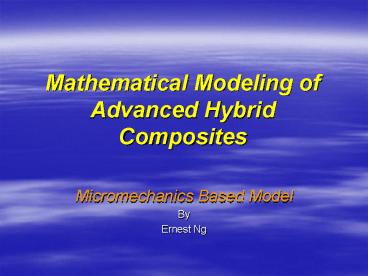Mathematical Modeling of Advanced Hybrid Composites PowerPoint PPT Presentation
1 / 20
Title: Mathematical Modeling of Advanced Hybrid Composites
1
Mathematical Modeling of Advanced Hybrid
Composites
- Micromechanics Based Model
- By
- Ernest Ng
2
Research Goal
To develop a micromechanics model to predict the
Overall Thermo-plastic Behavior of Hybrid
Composites
3
What is Hybrid Composites?
- Hybrid Composite is an elegant name of
engineering fiber-reinforced composite which
includes at least two fiber phases embedded
inside a matrix medium.
4
Fiber-reinforced Composites
For any fiber-reinforced composite, fibers have
to be fully embedded inside the matrix of the
composite. This matrix not only serves as a
load-transmitted medium but also exposed to the
environment. Moreover, materials used for matrix
phase are usually less stiffer than the fiber
materials. Consequently, the choice of materials
used for matrix materials is strongly affected by
the types of applications. Therefore, this is one
of the important issues if one wants to develop a
mathematical model to predict the overall
properties of the composite especially when the
composite is under inelastic deformation. Three
common types of fiber-reinforced composites used
in engineering applications
- Metal matrix composites
- Polymer matrix composites
- Ceramic matrix composites
5
Hybrid Composites
Fiber Phases
Matrix Phase
6
Why Hybrid Composites?
- High demand on using light-weighting materials in
transportation industry as to reduce fuel
consumption. - To take the advantages of different material
properties so as to optimize the usage of
engineering materials in order to achieve certain
design criteria. - More environmental friendly compare to
conventional metals.
7
Applications
8
Basic Assumptions
The composite mediums that are interested is
assumed to be Statistically Homogeneous. That is,
we can choose a Representative Volume Element
(RVE) such that it contains many phases and
reflects typical macroscopic properties of the
composite medium.
Volume Average of any Tensor Field
where F(x) is any tensor field which is Lebesgue
Integrable.
9
Aims of Micromechanics
- To estimate the local fields such as stress,
strain, displacement, electric and magnetic
fields of the heterogeneous materials under
overall external physical loadings such as
mechanical, thermal and electromagnetic
loadings - To estimate the overall effective properties of
heterogeneous materials such as stiffness,
thermal conductivity, coefficients of thermal
expansion, permittivity and permeability.
10
Methods of Approach
- Mean field approach
- Periodic field approach
- Variational approach
- Statistical approach
- Mechanics of materials
11
Method used in this study
A framework based method proposed by Dvorak G.J.
(1992) will be used throughout the study, namely
the Transformation Field Analysis (TFA). TFA is
a method to evaluate local fields and overall
properties. It relies on an explicit evaluation
of piecewise uniform approximations of residual
fields that are introduced in multiphase solids
by a distribution of piecewise uniform
eigenstrains or eigenstresses (such as thermal
strain, inelastic strain), jointly referred to as
Transformation Fields.
12
Mean-Field Equations
Average Local Field Equations
Overall Field Equations
Local-Global Field Equations
13
Idea of TFA
- Motivated by the existence of uniform field in
heterogeneous materials since it opens the way to
estimate the local field and concentration
factors. - Common thermo-mechanical fields such as thermal
strain inelastic strain can be treated as
Transformation Strain.
s8
µ
s8
14
Why TFA?
- Provide a general framework that are based on the
existence of uniform field in heterogeneous
solids to estimate the overall effective fields
of the composites. - Dont need to due with PDEs directly.
- Good for analyzing multi-phase fibrous solids.
- Suitable for computational work.
- Can easily incorporate with different inelastic
models and other micromechanics models.
15
TFA Equations
Average Local Field Equations
Overall Field Equations
Local-Global Field Equations
16
Auxiliary Equations
Overall Transformation Field Equations
Transformation Influence Functions
where G(x,x) is the Greens function d(x-x)
is the Dirac delta function.
17
Piecewise Approximation
Piecewise Uniform Approximation Equations
Governing Equations (Total Form)
18
Inelastic Equations
Phase Constitutive Relations
Governing Equations (Incremental Form)
19
Solution Strategy
Step 1 Solve for Transformation Concentration
Factors Methods Self-consistent Method,
Mori-Tanaka Method, Unit Cell
Step 2 Choose a plasticity model for each
phase i.e. Hardening rules, Flow rules, Yield
functions
Step 3 Develop a computer code to solve for the
systems of governing equations (i.e. Integrate
the incremental equations along some prescribed
path.)
20
Future Work
- Prepare a user subroutine (UMAT) for ABAQUS
- Modify and/or extend the existing TFA by
considering other factors such as fiber
interpenetration, imperfect interface bonding,
damage effect temperature dependent properties
etc - Consider other inelastic models.
- Impact analysis using ABAQUS.

